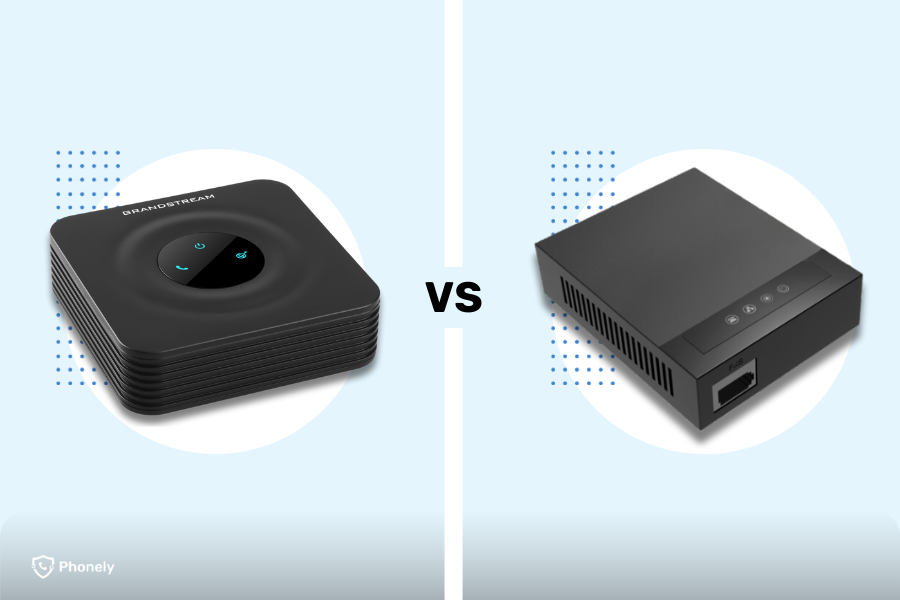With the world of telecoms changing rapidly, as we move from analogue to digital, you’re going to need to modernise your phone system. And if you want to do this without replacing absolutely everything, an analogue telephone adapter (ATA) is the way to go. The two most popular options out there for ATAs are the Grandstream HT801 and the Fanvil GA11, so let’s dive into a comparison and find out which one comes out on top.
What is an ATA?
If you’ve read our ATA blog then you’ll already be an expert on the subject, but for those who haven’t, here’s a brief overview. You can think of an ATA as a bridge that lets your old-school analogue phones work over the internet using home VoIP. You attach your handset to one end and attach the other end to your broadband router and voila – you now have a digital landline. ATAs really are a great option if you’re thinking about going digital, as you don’t have to worry about learning how to use unfamiliar hardware and they’re usually a lot cheaper than a brand-new handset.

Grandstream HT801 vs Fanvil GA11 – which adapter is better?
Let’s get into the nitty gritty now and break down the key differences between our two contenders. In terms of technical specifications, such as operating system, power interface etc., the two adapters are pretty much identical. There are, however, a few key differences between them that in our opinion lead to a standout winner – the Fanvil GA11.
| Feature | Grandstream HT801 | Fanvil GA11 |
| SIP Lines | 1 | 2 |
| Status Indicators | Power, Network, FXS | Power, Network, SIP, FXS |
| FXS Interface | RJ11 *1 | BT Plug *1 |
| Installation | Desktop | Desktop/Wall-mounted |
| Price | £35 – £40 | £49.99 |
SIP lines
The first advantage of the GA11 is the number of SIP lines. One SIP line corresponds to one user (ie, you) and each user has one number associated with it. So essentially, having two SIP lines means you can have two different phone numbers within just one adapter. This would be ideal for someone with a business number and a home number, as this would allow them to route all their calls through to the same phone.
Status indicator
There’s nothing worse than your tech breaking down and you haven’t got the first reason why – that’s where status indicators come in. Status indicators are the little green lights that show you which parts of the device are working, and which aren’t (you’ve probably seen them on your wi-fi router). Although both of our ATAs will let you know if the power, network and FXS (this is just your phone line) aren’t working, the GA11 will also check if your SIP line is still up and running.
Installation
Something that is often overlooked when considering ATAs or hardware in general really, is where to put the thing! The GA11 has a wall mount option, which allows you to install the ATA in a convenient location, freeing up desk or side-table space and improving accessibility.
FXS interface
Perhaps the most important difference between the two ATAs is the FXS interface, which in layman’s terms, just means where you plug your phone in! A huge benefit of the GA11 is that it uses the BT plug for its interface, which is compatible with the vast majority of phones. The HT801 however uses a different plug, which means you will most likely have to buy yet another adapter to use your old analogue phone.
Price
The only area that the HT801 beats out the GA11 in, is the price. Depending on who you buy from, you could save in the region of £10 – £15 if you choose to go with the HT801. However, it’s worth bearing in mind that the HT801 does come with the additional cost of the plug (interface) adapter (usually around £5 not including p&p) which does take a chunk out of that saving. And when you consider everything else we’ve discussed, there really is only one winner. After all, you get what you pay for!

Are there any other ATAs available?
Of course, there are other options for ATAs on the market, each with their own pros and cons. One example is the Grandstream HT802, which is the 2-port version of the HT801, allowing you to connect two handsets rather than one, but is more expensive than its 1-port counterpart. You may also be surprised to learn that Yealink doesn’t make ATAs. Although they’re one of the market leaders in VoIP phones, they haven’t dipped into the ATA market as yet.
The verdict
Both these ATAs are a solid and reliable choice if you’re thinking about entering the world of digital voice. However, if you’re looking for a feature-rich device that provides excellent value for money, the Fanvil GA11 stands out.
Don’t settle for less. Choose the Fanvil GA11 and let Phonely handle the rest. We offer competitive plans and unmatched support to meet your home phone needs. Check out our plans page to find out more.

Leave a Reply